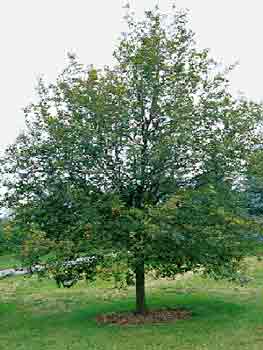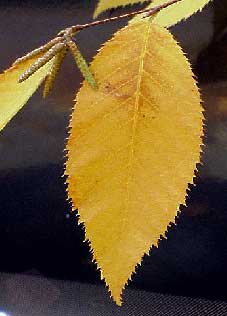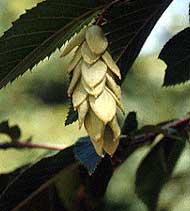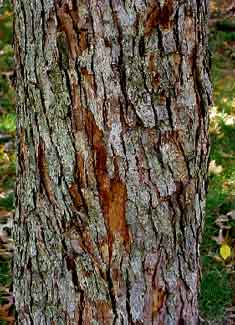 American Hophornbeam - Ostrya virginiana
American Hophornbeam - Ostrya virginiana
Birch Family (Betulaceae)
- Native habitat: Cape Breton, Ontario to Minnesota, and south to Texas and Florida; Mexico and Central America.
- Growth habit: Somewhat pyramidal when young, usually rounded or oval later. Has many horizontal or drooping branches.
- Tree size: Reaches a height of 25 to 40 feet with a spread two-thirds as wide. On rare occasions it reaches a height of 60 feet. Slow growth rate, averaging 10 to 15 feet over 15 years.
- Flower and fruit: Monoecious; male catkins are usually about 1 inch long, grouped in threes and visible throughout the winter. Female catkins are visible in April. Fruits are nutlets enclosed in "hop-like" pale green, papery capsules.
 Leaf: Alternate, simple leaves are 2 to 6 inches long and half as wide; dark green above and paler below. Leaves, which turn red-orange to yellow in autumn and fall early, feel like felt. They are not uniform, with those near the ends of the lower branches in the shade reaching a length of up to 6 inches, compared to much smaller leaves higher in the crown or farther back on the branches.
Leaf: Alternate, simple leaves are 2 to 6 inches long and half as wide; dark green above and paler below. Leaves, which turn red-orange to yellow in autumn and fall early, feel like felt. They are not uniform, with those near the ends of the lower branches in the shade reaching a length of up to 6 inches, compared to much smaller leaves higher in the crown or farther back on the branches.- Hardiness: Winter hardy to USDA Zone 3.
American hophornbeam, which loves hilly areas, has papery capsules containing nuts that are eaten by a variety of wildlife including grouse, bobwhite, deer, pheasant, rabbit and turkey. This tree has interesting reddish brown bark that is broken into narrow strips that are loose at both ends.

Its wood is very hard and is sometimes used to make tool handles. The tree has light brown heartwood and thick, white sapwood.
American hophornbeam was introduced into the landscape in 1690. The U.S. national champion is located near Grand Traverse, Mich., and is 74 feet tall with a 3-foot trunk.
 American hophornbeam should be transplanted balled- and-burlapped or from a container in early spring. It is difficult to reestablish after transplanting. The tree's tap root can be cut in the nursery to give it a root structure to better fit a specific location. It can also be grown in containers or root-control bags.
American hophornbeam should be transplanted balled- and-burlapped or from a container in early spring. It is difficult to reestablish after transplanting. The tree's tap root can be cut in the nursery to give it a root structure to better fit a specific location. It can also be grown in containers or root-control bags.


